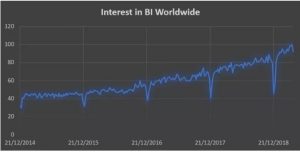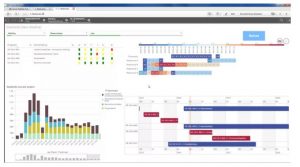From Project Controls to Project Intelligence
How can Business Intelligence offer added value within Project Controls?
In the information age, knowledge is essential to remain competitive. Companies are making a shift towards attaining a data-driven culture. Interest in Business intelligence is on a steady rise and today more and more companies are even investing in more advanced set-ups like combinations of big data with artificial intelligence.
As project controls engineers from Primaned, we can only share this enthusiasm because analysis is in our DNA. But what will this mean for the future of Project Controls? Will this trend be limited to the financial departments or will it expand to our domain?

Using the point-system from Google Trends as a measure it is obvious Business Intelligence is steadily gaining popularity since 2016, though it remains an unpopular talk-subject during Christmas dinners.
The ever-increasing pile of data
We need to improve to survive and gathering information is an important step in any improvement process. Companies often keep track of a very large range of data. But this is only half of the work. Throw a million numbers to a person and the chances are they can’t see the forest for the trees.
To gain insight, we need to scrutinize the data, assimilate it and convey it so it brings knowledge. One way to achieve this is through reports. However just as with raw numbers: throw a hundred reports to a person and they can’t see the forest all the same.
Interactive reports provide a way to slice the data just the way you want it, but still immediately display it in a sensible way. Dashboards focus on the higher level and make use of KPIs (Key Performance Indicators) for a quick evaluation of whether something is good or bad. Combine both with drill-through functionalities and near-live data refreshes and you’re on your way to mastering your own data.
What is BI?
BI stands for “Business Intelligence”. A definition from Azvine et al. (2005) reads:
Business intelligence (BI) is “about how to capture, access, understand, analyze and turn one of the most valuable assets of an enterprise – raw data – into actionable information in order to improve business performance” The term BI is often used to mean Interactive Dashboards as they are the main result of “Business Intelligence Tools”. However, in general BI reports can also be static.

Project Intelligence
The definition of business intelligence is very close to that of “Project Controls”. The biggest difference is that Project Controls focusses on improvements within a project environment whereas business intelligence looks toward the company as a whole.
From a data-perspective a project environment can also be quite complex. There are many different domains that need to be kept under control: schedule, costs, risks, resources, etc. And there are many parties that do the controlling: project manager, financial department, safety inspector, etc.
The data is usually spread among multiple sources. Creating reports can be time-consuming, diminishing the time available to properly analyze them.
It makes perfect sense to use BI and BI-tools to tackle this issue. The structure in the approach allows the reports to be generated quickly (sometimes even live) and are less prone to human error. Moreover, most tools are able to do data-modelling so information from the different sources about different project domains can be combined.
Another trend in Project Controls, BIM (Building Integrated Modelling), is focusing on just that; combining project data from multiple sources to get a general overview. In this way BIM and BI are somewhat related though BI focusses on visualizations.
Way forward
As Primaned, we welcome the trend towards data-driven cultures. Currently, we often see a lack of integration between the different project domains which limits the power of project controls and we think BI can help with this. However, not all BI is automatically good BI, it’s not good to spend thousands of euros into a BI-solution if the organization doesn’t profit from it in the longer run. You can usually already start and achieve nice things with the tools you already have available.
The automation trend also doesn’t eliminate the role of the Project Controls engineer. It shifts the focus from repetitive preparations back to the analysis. BI can be programmed to tell you what is going well and what is going bad, sometimes with some drill-down possibility, but it mostly still requires some in-depth analyses to give an explanation as to why certain things go bad.
BI gives you the objective facts about the things you want to look at, in very fast way. Learn from past strengths and mistakes and make better informed decisions for the future!
If you’re interested in Business intelligence and its applications for Project Controls, stay tuned! We’ve got more posts coming soon that will go more into detail on this topic.



